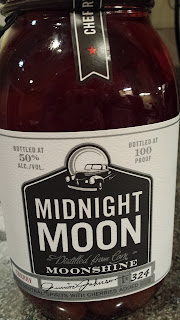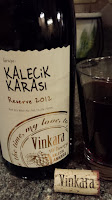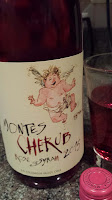 This month Furmint USA conducted a ten day marketing blitz in NYC and Washington DC showcasing Hungary's signature white grape Furmint. Most wine consumers are unwittingly familiar with the grape through its use in the prestigious Tokaji Aszu dessert wines. As the name suggests, Furmint dominates the Tokaj region which was the world's first appellation control designated long before Bordeaux and even Port wine. The region is rich in volcanic soil with the plateau protected by the Carpathian Mountains.
This month Furmint USA conducted a ten day marketing blitz in NYC and Washington DC showcasing Hungary's signature white grape Furmint. Most wine consumers are unwittingly familiar with the grape through its use in the prestigious Tokaji Aszu dessert wines. As the name suggests, Furmint dominates the Tokaj region which was the world's first appellation control designated long before Bordeaux and even Port wine. The region is rich in volcanic soil with the plateau protected by the Carpathian Mountains.  The goal of this media campaign was not only to introduce the U.S. market to Furmint wine, but also to emphasize the breadth of styles available to the consumer. Yes, there are the delicious sweet versions represented by Aszu and Szamorodni wines. But Furmint wines are also encapsulated in range of dry styles from bright acids to creamy layers of citrus.
The goal of this media campaign was not only to introduce the U.S. market to Furmint wine, but also to emphasize the breadth of styles available to the consumer. Yes, there are the delicious sweet versions represented by Aszu and Szamorodni wines. But Furmint wines are also encapsulated in range of dry styles from bright acids to creamy layers of citrus.One of these events was a trade tasting at the Embassy of Hungary. There were 17 Furmint wines poured which included several single vineyard wines providing a peek into terrior, particular the the affects of the volcanic, clay, or limestone soil. A common element among the wines which Shannon Jones of Grape Occasions and I discussed was a funky character that many Hungarian wines possess. I believe this is the result of the frequent use of native yeast and long spontaneous fermentation that these wines undergo.

 We started with the bright and acidic Béres Vineyards and Winery 2014 Estate Furmint ($19) which also possessed a hint of minerals drawn from the volcanic soils. That was soon contrasted to the Barta Winery 2012 Old King Furmint ($38) a creamy and velvety wine with an interesting orange citrus profile - as opposed to the more common lemon profile. Winemaker Attila Homonna was present to describe the Burgundian fermentation process using neutral oak barrels for fermentation and 7 months aging. This wine represents the historic Old King Vineyard where grapes have been planted since the 13th century.
We started with the bright and acidic Béres Vineyards and Winery 2014 Estate Furmint ($19) which also possessed a hint of minerals drawn from the volcanic soils. That was soon contrasted to the Barta Winery 2012 Old King Furmint ($38) a creamy and velvety wine with an interesting orange citrus profile - as opposed to the more common lemon profile. Winemaker Attila Homonna was present to describe the Burgundian fermentation process using neutral oak barrels for fermentation and 7 months aging. This wine represents the historic Old King Vineyard where grapes have been planted since the 13th century.Another representative was Natalia Demko from Holdvölgy Winery (Valley of the Moon). Like most Hungarian wineries, this is a family venture, but uniquely, the winery includes a century old 2km (1.25 mile) cellar network. If you are fortunate to visit the estate, the tastings are conducted at various spots within their cellar trail. And expect tasty wines. Their 2013 Vision Furmint ($24) is fresh, lemony, and acidic whereas the 2012 Hold and Hollo Dry Furmint ($21) has more depth and stone fruit flavors.
 Gróf Degenfeld Winery provided an off-dry style of Furmint through their 2013 Estate Furmint ($18) which like a well made Riesling, balances the extra sugar with abundant acidity. And their tasty 2014 Zomborka Furmint is produced from organic grapes harvested from the Zomborka Vineyard.
Gróf Degenfeld Winery provided an off-dry style of Furmint through their 2013 Estate Furmint ($18) which like a well made Riesling, balances the extra sugar with abundant acidity. And their tasty 2014 Zomborka Furmint is produced from organic grapes harvested from the Zomborka Vineyard. Before the tasting I was most familiar with the dry Furmint wines from Erzsébet Cellar - having sampled their wines during previous media tastings in while in Budapest. Thus I was excited to meet winemaker Miklos Pracser Jr. who along with his sister Hajnalka operate the winery with their parents. Their 2012 Estate Vineyard ($21) has been a frequent visitor to my wine glass and is dry, show fresh lemons, and has an extraordinary long acidic finish. I returned a second time to the 2012 Zafír Furmint ($25) which possessed a stronger bouquet and rounder profile - most likely from the addition of some Hárslevelű. This single vineyard wine was my favorite of the evening.
Before the tasting I was most familiar with the dry Furmint wines from Erzsébet Cellar - having sampled their wines during previous media tastings in while in Budapest. Thus I was excited to meet winemaker Miklos Pracser Jr. who along with his sister Hajnalka operate the winery with their parents. Their 2012 Estate Vineyard ($21) has been a frequent visitor to my wine glass and is dry, show fresh lemons, and has an extraordinary long acidic finish. I returned a second time to the 2012 Zafír Furmint ($25) which possessed a stronger bouquet and rounder profile - most likely from the addition of some Hárslevelű. This single vineyard wine was my favorite of the evening.  The one non-Tokaj producer was St. Donat Estate which is located in Csopak overlooking Lake Balaton. This region provides clay and limestone soils and a unique micro-climate provide by lake affect conditions. Their soils vary with the 2013 Márga Furmint ($24) raised in clay infused marl and the 2014 Estate Furmint ($20) grown in limestone. The former is a beautiful wine, creamy & mineral driven with a long finish. The later is on the brighter side, with more green apples than most of the assembly.
The one non-Tokaj producer was St. Donat Estate which is located in Csopak overlooking Lake Balaton. This region provides clay and limestone soils and a unique micro-climate provide by lake affect conditions. Their soils vary with the 2013 Márga Furmint ($24) raised in clay infused marl and the 2014 Estate Furmint ($20) grown in limestone. The former is a beautiful wine, creamy & mineral driven with a long finish. The later is on the brighter side, with more green apples than most of the assembly. There were also sweet wines represented by the Barta Winery 2013 Szamorodni Sweet Furmint ($47) and the Basilicus Winery 2012 Szamorodni Sweet Furmint ($30). Szamorodni refers to "édes" wines made from botrytised grapes and like this wine capture the apricot aspect of Aszu wines without the higher price tag.
Egészségére to Furmint, whether dry or sweet, and to Hungarian wine.











































